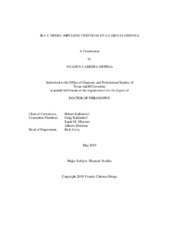| dc.description.abstract | This study analyzes the differences and similarities among the multiple portrayals of mythological figures as embodiments of human emotions (or “affects” as Freud calls them), especially rage and erotic desire, from Ancient Greece to the present. I posit that the fusion of love and rage in classical characters like Achilles and Medea triggers dissent and subversion against any form of external control or manipulation of human behavior (ideological, political, religious, etc.), what renowned Latin Americanist critic Alberto Moreiras defines as “Infrapolitics” in Marranismo e inscripción (2016).
I study literature, theatrical plays, choreographies and films from a wide range of countries, namely Spain, Uruguay, Colombia, Mexico, Cuba, and the United States. The thesis of this dissertation is that, in the different Hispanic versions of these classical myths, violence and love have been intimately connected with classical figures in ways that underline their universal iconic nature. Moreover, the blend of rage and love as triggers for dissent and subversion, allows classical characters –in both ancient and more contemporary versions– to go beyond any kind of boundaries (geographical, religious, sexual, etc.) to ponder topics common to all humanity. I study how human impulses, embodied by these reimagined classical characters, become driving forces (or “thymotic forces” as Peter Sloterdijk calls them in Rage and Time, 2006) that resist and subvert any form of behavioral normativity.
Violence and erotic desire are the most prevalent thymotic forces in these artistic and literary works; they also represent universal concepts that connect myth and history, past and present, freedom and control, illegality and laws. The distinctiveness of Medea, Achilles and Oedipus stems directly from their common connection to these thymotic forces. I argue that the differences among the multiple versions of the same myths, including their varied reception in the Hispanic World, arise from the different views on rage and erotic desire filtering through all of these depictions. The ways Achilles, Medea and Oedipus have been read by contemporary audiences also disclose powerful insights from Antiquity until today about what makes us human. | en |


